Search Results
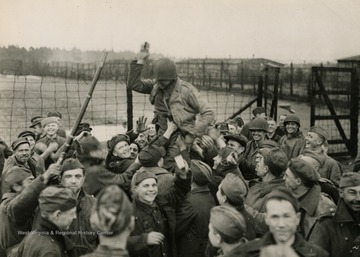
- IDNO:
- 041191
- Title:
- Russian Prisoners of War Liberated By Advancing U.S. Troops
- Date:
- ca. 1945
- Description:
- Information on back of photo reads: "Liberated Russians cluster around a Ninth U.S. Army soldier, carried high on their shoulders, for cigarettes, which they had not seen in many months. When the American finally convinced the Russians that he had no more, they "chaired" him and carried him around the yard before their former prison, the Nazi Stalag 326, south of Bielefeld. The first U.S. troops reached Stalag 326 April 2, 1945. Nine thousand Russian prisoners of war were liberated but thousands were at the point of starvation. Tubercular patients numbered 1,350. in vast mounds all around the camp, 30,000 Russians, most of them starved to death, were buried in heaps of 500. Major Gregory Matviev, who was captured in Sebastopol in 1942, reported that hundreds died daily of starvation and "about 50 were shot every other day for no reason at all.""
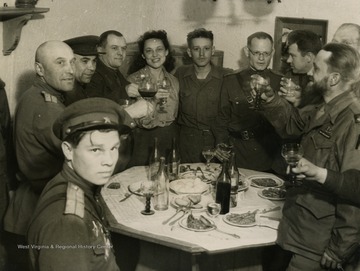
- IDNO:
- 041192
- Title:
- U.S. Troops Meet Russians in Torgau, Germany
- Date:
- ca. 1945
- Description:
- Information on back of photo reads: "Russians and Americans toasting each other after the link up at Torgau. Ann Stringer, U.P. Correspondent can be seen in the picture. Also man with beard on right, who is Correspondent Jack Thompson, of Chicago Tribune."
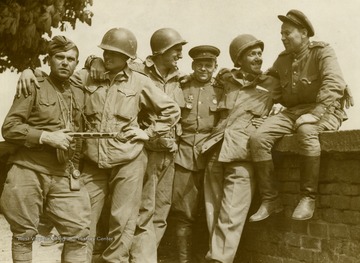
- IDNO:
- 041194
- Title:
- U.S. and Red Armies Link Up, Torgau, Germany
- Date:
- ca. 1945
- Description:
- Information on back of photo reads: "Firm contact has been established between ground forces of the First American Army and those of the Russian Army. The historic meeting took place in the town of Torgau, on the Elbe River, 75 miles south of Berlin, when First Army troops met forward elements of the Russian Guards Division."
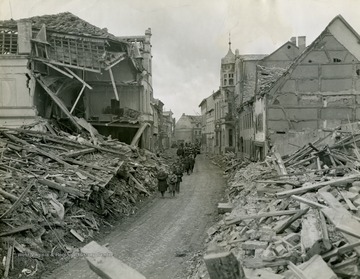
- IDNO:
- 041196
- Title:
- German Civilians March Through Newly Captured Zulpich, Germany
- Date:
- ca. 1945
- Description:
- Information on back of photo reads: "German civilians march through newly captured Zulpich, Germany, to receive instructions on their conduct from military government unit with 9th Infantry Division of 1st U.S. Army. Town was hard hit by U.S. bombers blasting path to Rhine."
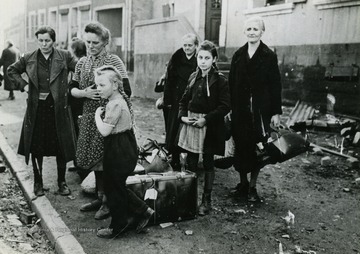
- IDNO:
- 041197
- Title:
- German Civilians Evacuated From Battle Area, Schaffhausen, Germany
- Date:
- ca. 1945
- Description:
- Information on back of photo reads: "German civilians are rounded up for evacuation from Schaffhausen, occupied by Seventh U.S. Army troops March 14, 1945. The German town, six miles north of the frontier of Alsace, is under constant enemy shellfire."
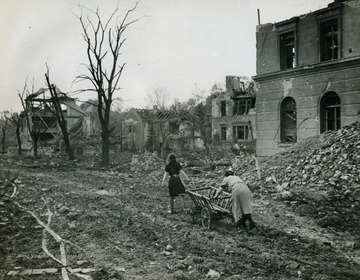
- IDNO:
- 041198
- Title:
- German Refugees Move Through Ruins of Regensburg, Germany
- Date:
- ca. 1945
- Description:
- Information on back of photo reads: "German refugees with a cart move through the ruins of bombed Regensburg, captured by the 65th Division of the Third U.S. Army April 23, 1945. General George Patton's Third Army struck into the Southern German segment from the northwest to capture the Danube River town, which is about 70 miles from Munich."
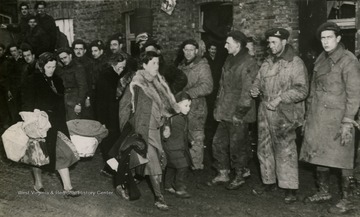
- IDNO:
- 041199
- Title:
- Humiliated German Women Pass Through Canadian Lines to Evacuation Center
- Date:
- ca. 1945
- Description:
- Information on back of photo reads: "Shame, guilt, and humiliation cloud the faces of these German women as they pass through the Canadian lines to an evacuation centre. They put guns before butter in the years between the wars; they lived on the loot of conquered Europe, and clothed themselves in furs from Russia and fine clothes from Paris. Now it is their turn to be homeless, and the watching troops, who saw grim evidence of German ruthlessness in the countries they liberated, show no sympathy."
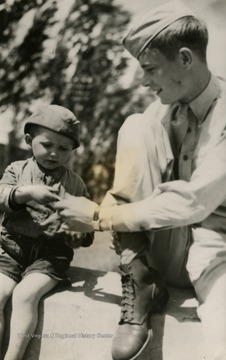
- IDNO:
- 041200
- Title:
- U.S. Soldier Introduced Russian Lad to Chewing Gum
- Date:
- ca. 1945
- Description:
- Information on back of the photo reads: "Puzzled but curious, a little Russian boy accepts a stick of chewing gum from his new friend, a U.S. Air Forces solider at the Russian terminus of Italy-Russia shuttle missions flown by heavy bombers of the U.S. Fifteenth Army Air Force. Since June, 1944, Allied bombers from England and Italy, escorted by fighters, have flown to bases in Russia, and return, attacking enemy targets in occupied Europe en route."
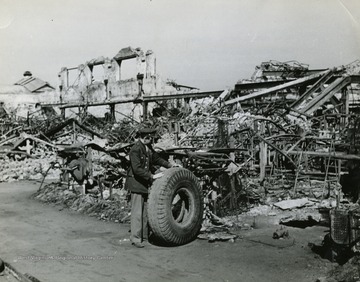
- IDNO:
- 041201
- Title:
- Hanau Dunlop Rubber Plant Gutted, Hanau, Germany
- Date:
- ca. 1945
- Description:
- Information on back of photo reads: "If German divisions no longer retreat according to plan, part of their difficulties can be traced to the destruction of Deutsche Dunlop A.G. tire and rubber factory at Hanau, Germany, east of Frankfurt - a priority - one target for R.A.F. and the U.S. Eighth Air Force. When American Air Force observers surveyed the second most important rubber plant on the Continent, they found ruin and destruction widespread. Despite this the enemy's need for rubber products is so great, there was evidence of clearance and repair work to restore partial production, said surveyors. Elsewhere in Hanau the locomotive roundhouse had been destroyed by Allied air attacks. The town's gas works was a shambles. in the marshalling yard sidings and through lines were pocketed with bomb craters, some filled - in attempts to keep the rails open. In one typical Hanau attack last December, the Eighth sent 303 heavy bombers to drop in one-ton (U.S.) bombs, 1,112 one-thousand pounders, 176 five-hundreds, and 3,420 hundred-pound bombs."

- IDNO:
- 041203
- Title:
- Third U.S. Army Troops Go Aboard LCVP, Nierstein, Germany
- Date:
- ca. 1945
- Description:
- Information on back of photo reads: "3rd U.S. Army Troops go aboard LCVP prior to first crossing of the Rhine River by soldiers of the 3rd Army at Nierstein, Germany. Soldiers are members of the 5th Infantry Division."
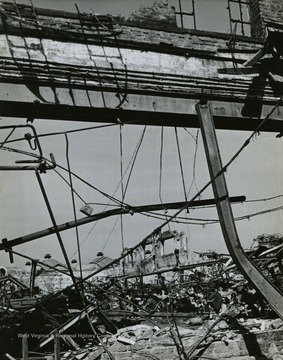
- IDNO:
- 041204
- Title:
- Hanau Dunlop Rubber Plant Gutted, Hanau, Germany
- Date:
- ca. 1945
- Description:
- Information on back of photo reads: "If German divisions no longer retreat according to plan, part of their difficulties can be traced to the destruction of Deutsche Dunlop A.G. tire and rubber factory at Hanau, Germany, east of Frankfurt - a priority - one target for R.A.F. and the U.S. Eighth Air Force. When American Air Force observers surveyed the second most important rubber plant on the Continent, they found ruin and destruction widespread. Despite this the enemy's need for rubber products is so great, there was evidence of clearance and repair work to restore partial production, said surveyors. Elsewhere in Hanau the locomotive roundhouse had been destroyed by Allied air attacks. The town's gas works was a shambles. in the marshalling yard sidings and through lines were pocketed with bomb craters, some filled - in attempts to keep the rails open. In one typical Hanau attack last December, the Eighth sent 303 heavy bombers to drop in one-ton (U.S.) bombs, 1,112 one-thousand pounders, 176 five-hundreds, and 3,420 hundred-pound bombs."

- IDNO:
- 041205
- Title:
- Bastion of Hitler's Eastern Front Falls, Ukraine
- Date:
- ca. 1945
- Description:
- Information on back of photo reads: "Tarnopal, bastion of Hitler's eastern front, turns a scarred face to the camera after its fall with its 12,000 man garrison to Soviet troops. Fighting in and around Tarnopol was prolonged and bitter, and German losses in men and material were heavy."